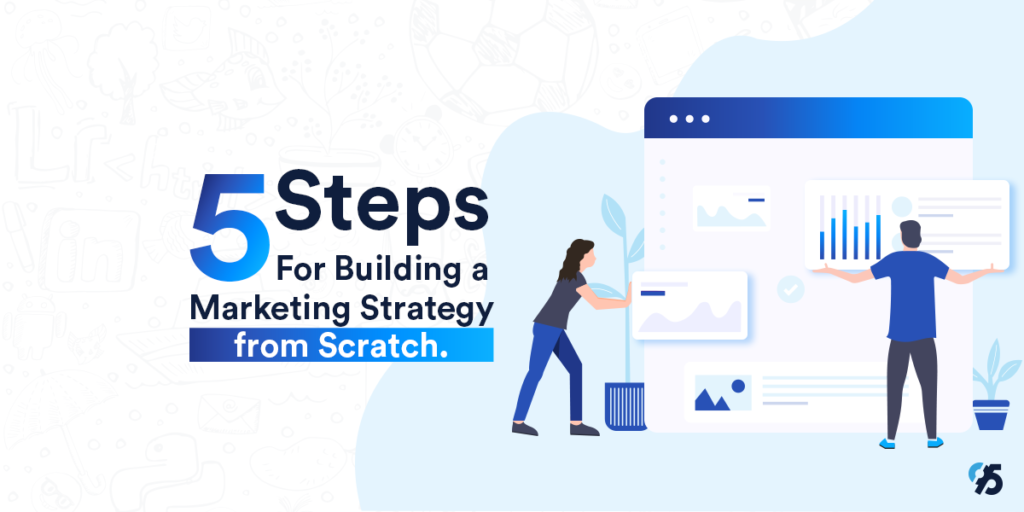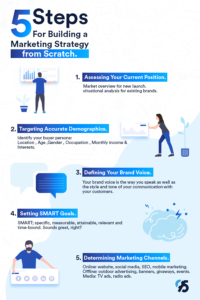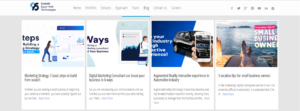Marketing Strategy: 5 basic steps to build it from scratch Infograph

Created: 18 Aug, 2018
Last Edit: 03 Oct, 2024
Whether you are starting a small business or beginning your career as a marketer, you have probably figured out by now that the way you showcase your brand or product will either capture your audience or send them away. Starting to present your brand or the product is tricky, that’s why you need a killer marketing strategy to start, otherwise; you are shooting blind arrows in the air.
Establishing a thorough and detailed marketing strategy will help put your business on a roadmap towards success. You can not reach your destination without following specific directions. These directions will ultimately guide you through a safer route and towards more accurate results.
So, let’s start building your marketing strategy step by step from scratch.

1. What’s really going on?
Let’s dig deep into assessing our current situation!
Any company or business offering a product and service should be fully aware of the strengths and weaknesses of what they are offering. Benchmarks will help you take advantage of uncharted territories in the market, as well as better understanding your weaknesses.
Pre-launch
It is beneficial to build a market overview as well as an STP (Segmentation, Targeting and Positioning). This will guide you into launching your product or service in the market with more confidence and understanding of its niche. Also, check the 4Ps of Marketing Mix which could add a lot to how you view your product or service and assess it.
Post-launch
You will need a situational analysis. In order to properly assess your product or service, begin by writing down your best and worst features. After that, run a competitor analysis in which you list your best and worst features against competitors’ to understand where you stand in the market.
Here’s a pro tip!
Don’t forget to list your USP (Unique Selling Propositions), which are only specific to you and set you apart in the market. Including one or several USP will give your marketing strategy a powerful advantage.
How do I actually do that?
Well, for instance, the shoes we offer are made from the highest quality materials but they are more expensive when benchmarked with competitors. In this case, we have attained the strengths (high-quality materials) and weaknesses (higher price) of the product in question. This enables us to further move on to highlighting the strengths in our marketing strategy and using them to attract the right clients.
Not everyone is going to want to spend that extra buck or two to get the best quality but there are people who do. That’s why after zeroing in on your statement features, you need to focus on who you will be interested in those features.
2. Reaching the right people
Basically understanding your target audience.
For your marketing content to work, it needs to be tailored to the right people. Depending on the type of product or service you are offering, the type of person more likely to be interested in you will be different. When you find out that type of person and customize your content to fit them, your content will be more focused and effective; therefore, bringing you better results.
You can start segmenting your audience into your marketing strategy by asking questions like:
Who are they?
What do they do?
Which need motivates them to buy?
What is their purchase journey like?
Where or how do they shop (online or IRL)?
When do they look for my product\service?
How do they qualify their product\service provider?
This will assist you in facilitating any hardships that face your clients while they attempting to purchase your product or service.
“Great marketers see potential customers as real people. They create campaigns that
appeal to their, wants, needs and desires.”
― Stacey Kehoe
In collecting your data, you can use analytics websites, social media channels, customer reviews or real-life surveying and interviewing of potential customers.
What happens if I don’t do the work?
You don’t want to be putting all your efforts into selling 500 EGP shoes for someone who can only afford 200 EPG shoes.
What’s next?
You should then categorize your data into profiles that are called “buyer personas”.
3. Who am I?
Brand
In order to start speaking to your audience, you need a consistent and engaging brand and voice. In coming up with your brand’s shape, you need to keep in mind that it is an investment; therefore, your choices should be measured, tested and precisely thought out.
Don’t fall for that mistake!
Your brand name should not be built on a specific trend because trends wear off and you are left stuck with a name from 2005. Likewise, your brand logo should be clear and catchy. Your brand elements like name, logo, colors used, slogan and tagline should all be compatible with each other; that gives your brand a strong and professional presence.
Voice
Your brand voice is the way you speak as well as the style and tone of your communication with your customers. It is basically your brand’s personality which builds the relationship with your audience.
Don’t freak out yet, it’s easy peasy!
In defining your brand’s voice, start by labeling it with three adjectives. We determine these three adjectives based on listening to our potential clients and the way they communicate in their day to day life. For instance, our shoe brand is “sophisticated, bold, edgy”. What do you think?
By having insight into our buyer persona (Sarah), we now understand how to answer her inquiries, have some fun banter with her and showcase our latest products to her in the most attractive fashion.
4. You can’t have a marketing strategy without goals
Now that you have an understanding of your brand, potential clients, and market, it is time to set goals for your business marketing strategy based on your gathered info.
Setting goals like “sell more shoes” or “reach more people” or “build a more powerful brand” is okay, but how will you measure their success?
For setting your marketing goals, we recommend using the Hubspot SMART goals template. This template allows you to set goals according to a model called SMART; specific, measurable, attainable, relevant and time-bound. Sounds great, right?
5. Be in all the right places
Setting your goals was a lengthy process, but the next step is even trickier. It is all about the “how”. How will achieve these goals?
There are lots of options when it comes to marketing methods. Determining which ones work for your business is sometimes a bit confusing and requires some trial and error. Generally speaking, for your marketing strategy plan to be thorough, it needs to include marketing tactics depending on:
● The nature of your product or service.
● Where your potential clients are.
For instance, Sarah is most likely to respond to advertising and word of mouth as opposed to digital marketing.
Here’s a list of marketing channels through which you can reach your audience:
Owned
Those are the marketing channels that your business owns, that includes your website, blog or social media profiles.

Earned
Those are the external marketing channels that cover your business, that includes articles on other blogs, press coverage for your event or your SEO rankings.


Paid
Those are the budgeted marketing channels that your business affords, that includes TV or print advertising and sponsored social media posts.
The best marketing strategies try to incorporate all 3 elements into their marketing strategy for a more wholesome approach. Combining these elements together mixes in your traditional marketing techniques and tactics with all the modern nuances.
These 5 steps are sure to help you set an extensive marketing strategy for your business; in order to make the most out of your product or service, whilst also achieving the best results. Now it is left for your team to come up with cool and unique marketing ideas to execute within your marketing strategy plan. Start now!
If your marketing strategy is not fulfilling the results you need, consider a Digital
Marketing Consultant that can boost your business in 6 ways.
Created: 18 Aug, 2018
Last Edit: 03 Oct, 2024
Read Also

Website Development Cost in Egypt – Plan Your Budget

خطوات كتابة محتوى تسويقي ناجح

أفضل أنواع التسويق الالكتروني في السعودية للشركات والأعمال في السعودية

مميزات المنصات الإلكترونية

7 key elements to include in your company profile to win more leads


